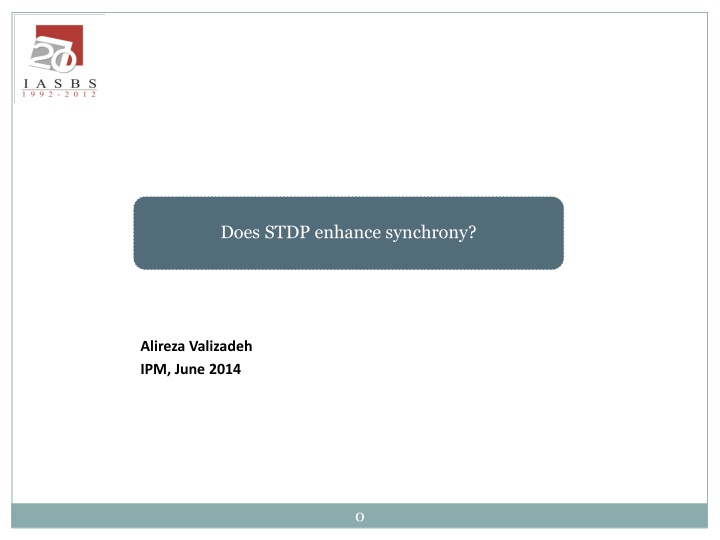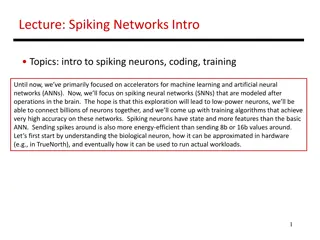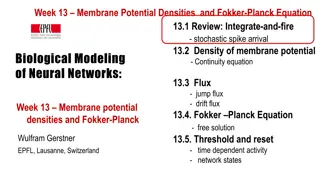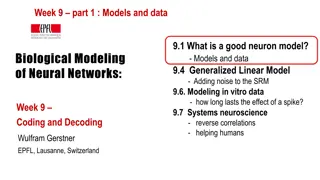Effects of Spike-Timing-Dependent Plasticity (STDP) on Synchrony in Neural Networks
This presentation delves into the impact of Spike-Timing-Dependent Plasticity (STDP) on synchrony within neural networks, examining how the structural effects of STDP enhance synchrony and influence network dynamics. Various forms of STDP, such as pair-based additive STDP and variations like nonlinear weight-dependent STDP, are explored alongside their effects on synchronization. Insights from studies by researchers like Alireza Valizadeh, Gilson et al., Bayati and Valizadeh, and more shed light on the intricate relationship between STDP and network synchrony.
Download Presentation

Please find below an Image/Link to download the presentation.
The content on the website is provided AS IS for your information and personal use only. It may not be sold, licensed, or shared on other websites without obtaining consent from the author.If you encounter any issues during the download, it is possible that the publisher has removed the file from their server.
You are allowed to download the files provided on this website for personal or commercial use, subject to the condition that they are used lawfully. All files are the property of their respective owners.
The content on the website is provided AS IS for your information and personal use only. It may not be sold, licensed, or shared on other websites without obtaining consent from the author.
E N D
Presentation Transcript
Does STDP enhance synchrony? Alireza Valizadeh IPM, June 2014 0
Stress: Evolution is lazy Man in cave Civilized man Man in Mars 1
Outline - Synchronization - STDP: An overview - Does the structural effects of STDP enhances synchrony? - What is the impact of synchrony on the structure of networks? 2
Pair-based additive (conventional) STDP - Loop elimination - Effect on Synchrony Gilson et al., Biological Cybern. (2009). Kozlosky and Cecci, Front Neural circuits (2010). 3
STDP and synchronization Bayati and Valizadeh, Phys. Rev. E (2012). 4
STDP profile Song et al. Nature Neurosci. (2000). 5
Causal association William James (1890) : those tracts of conduction which have been already most in use! habits in living beings are due to plasticity of the organic materials the currents, once in, must find a way out they leave traces Donald Heb (1949): Let us assume that the persistence or repetition of an activity (or "trace") tends to induce lasting cellular changes that add to its stability. When an axon of cell A is near enough to excite a cell B and repeatedly or persistently takes part in firing it, some growth process or metabolic change takes place in one or both cells such that A's efficiency, as one of the cells firing B, is increased. The Principles of Psychology (1890), Dover Publications, 1950. The Organization of Behavior (1949), New York: Wiley & Sons. 6
Variations on Conventional STDP - Nonlinear weight-dependent STDP (Gutig et al., 2003; Morrison et al.,2007) - Triplet-based STDP (Pfister and Gerstner, 2006) - Voltage based plasticity (Clopath et al., 2010) - Pair-based with shifted profile (Babadi and Abbott, 2010) 7
STDP and synchronization Lubenov and Siapas, Neuron (2008). 8
STDP and synchronization Lubenov and Siapas, Neuron (2008). 9
STDP and synchronization Knoblauch et al., Front. Comput. Neurosci. (2012). 10
Concluding remarks - Synchronization properties of the neuronal networks depend on delay time and the response of the neurons which is quantified by the phase response curves. - Impact of STDP on the synaptic weights and consequently on the dynamics also depends on the axonal and dendritic delay times. - In a more general study on the structural and the dynamical outcomes of STDP, the type of excitability of neurons should be taken into account. 11























